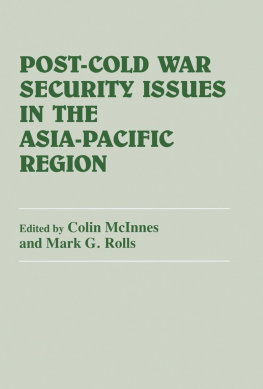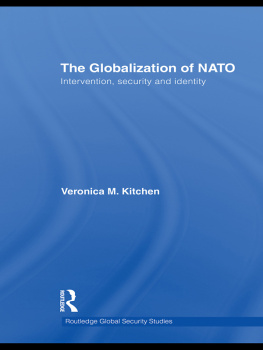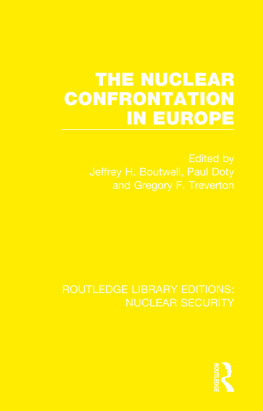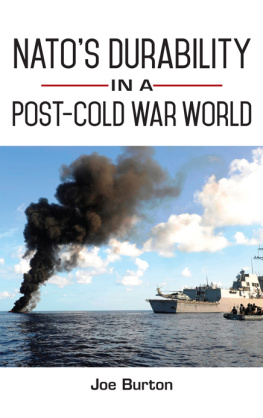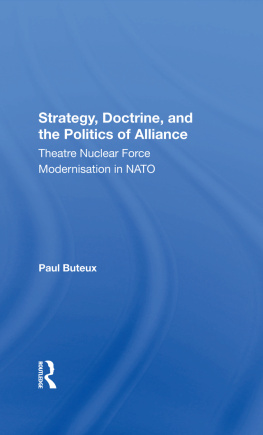ROUTLEDGE LIBRARY EDITIONS: COLD WAR SECURITY STUDIES
Volume 30
NATOS CHANGING STRATEGIC AGENDA
First published in 1990 by Unwin Hyman Ltd
This edition first published in 2021
by Routledge
2 Park Square, Milton Park, Abingdon, Oxon OX14 4RN
and by Routledge
52 Vanderbilt Avenue, New York, NY 10017
Routledge is an imprint of the Taylor & Francis Group, an informa business
1990 Colin McInnes
All rights reserved. No part of this book may be reprinted or reproduced or utilised in any form or by any electronic, mechanical, or other means, now known or hereafter invented, including photocopying and recording, or in any information storage or retrieval system, without permission in writing from the publishers.
Trademark notice: Product or corporate names may be trademarks or registered trademarks, and are used only for identification and explanation without intent to infringe.
British Library Cataloguing in Publication Data
A catalogue record for this book is available from the British Library
ISBN: 978-0-367-56630-2 (Set)
ISBN: 978-1-00-312438-2 (Set) (ebk)
ISBN: 978-0-367-61240-5 (Volume 30) (hbk)
ISBN: 978-1-00-310481-0 (Volume 30) (ebk)
Publishers Note
The publisher has gone to great lengths to ensure the quality of this reprint but points out that some imperfections in the original copies may be apparent.
Disclaimer
The publisher has made every effort to trace copyright holders and would welcome correspondence from those they have been unable to trace.
NATOs Changing Strategic Agenda
THE CONVENTIONAL DEFENCE OF CENTRAL EUROPE
Colin Mclnnes
Colin Mclnnes 1990
This book is copyright under the Berne Convention. No reproduction without permission. All rights reserved.
Published by the Academic Division of Unwin Hyman Ltd
15/17 Broadwick Street, London W1V 1FP, UK
Unwin Hyman Inc.
955 Massachusetts Avenue, Cambridge, MA 02139, USA
Allen & Unwin (Australia) Ltd
8 Napier Street, North Sydney, NSW 2060, Australia
Allen & Unwin (New Zealand) Ltd in association with the Port Nicholson Press Ltd
Compusales Building, 75 Ghuznee Street, Wellington 1, New Zealand
First published in 1990
British Library Cataloguing in Publication Data
Mclnnes, Colin, 1960
NATOs changing strategic agenda: the conventional
defence of Central Europe.
1. North Atlantic Treaty Organisation. Strategy
I. Title
355.031091821
ISBN 004445211X
Library of Congress Cataloging in Publication Data
Applied for
Typeset in 10/11 point Bembo
Printed by Billing and Sons Ltd, London and Worcester
For Sally
From now on Im thinking only of me.
Major Danby replied indulgently with a superior smile: But, Yossarian, suppose everyone felt that way.
Then, said Yossarian, Id certainly be a damned fool to feel any other way, wouldnt I?
Joseph Heller, Catch 22
Contents
2 The central front
The political context
The geography of the central front
NATO : organization and deployment
The WTO : organization and deployment
Conclusion
3 The balance of forces
Bean counting
Measuring force effectiveness
Analysing combat dynamics
Conclusion
4 Soviet military doctrine
The Great Patriotic War
Stalin and the nuclear age
The revolution in military affairs
Developing a conventional variant
The Ogarkov revolution
Gorbachev and new thinking
Conclusion
5 NATO operational doctrine
AirLand Battle and US army doctrine
Defending northern Germany: the British- NORTHAG concept of operations
Follow-on forces attack ( FOFA )
Conclusion
6 Non-offensive defence
The development of non-offensive defence
The spider and the web: the SAS model
Characteristics of non-offensive defence
Criticisms of non-offensive defence
Conclusion
- 2 The central front
- The political context
- The geography of the central front
- NATO: organization and deployment
- The WTO: organization and deployment
- Conclusion
- 3 The balance of forces
- Bean counting
- Measuring force effectiveness
- Analysing combat dynamics
- Conclusion
- 4 Soviet military doctrine
- The Great Patriotic War
- Stalin and the nuclear age
- The revolution in military affairs
- Developing a conventional variant
- The Ogarkov revolution
- Gorbachev and new thinking
- Conclusion
- 5 NATO operational doctrine
- AirLand Battle and US army doctrine
- Defending northern Germany: the British-NORTHAG concept of operations
- Follow-on forces attack (FOFA)
- Conclusion
- 6 Non-offensive defence
- The development of non-offensive defence
- The spider and the web: the SAS model
- Characteristics of non-offensive defence
- Criticisms of non-offensive defence
- Conclusion
Guide
Special thanks are due to the officers and officials of the UK Ministry of Defence, NATO and SHAPE who spared the time to talk to me but who cannot be mentioned by name, and to Lt. Col. Roger Smith and the staff of the Tactical Doctrine Retrieval Centre, Army Staff College, Camberley, for their willing help in tracking down source material. I would also like to thank Ken Booth and David Gates for their advice at various stages, and to Gary Sheffield who prompted the research in the first place. Finally I would like to tnank Susan Davies and Marian Davies for their word processing skills, and Pete Wright for his help and advice with computers.
| ADE | Armoured Division Equivalent |
| AFNORTH | Allied Forces Northern Europe (NATO) |
| AFSOUTH | Allied Forces South (NATO) |
| ATACMS | Army Tactical Missile System (NATO) |
| ATAF | Allied Tactical Air Force (NATO) |
| ATGM | Anti-tank Guided Munition |
| CENTAG | Central Army Group (NATO) |
| C3 | Command, Control and Communications |
| C3I | Command, Control, Communications and Intelligence |
| CAS | Close Air Support |
| CFE | Conventional Forces in Europe |
| CGF | Central Group of Forces (WTO) |
| DIVAD | Divisonal Army Defence Gun (US) |
| ERA | Explosive Reactive Armour |
| ET | Emerging Technology |
| FEBA | Forward Edge of the Battle Area |
| FIBUA | Fighting In Built Up Areas |
| FLET | Forward Line of Enemy Troops |


